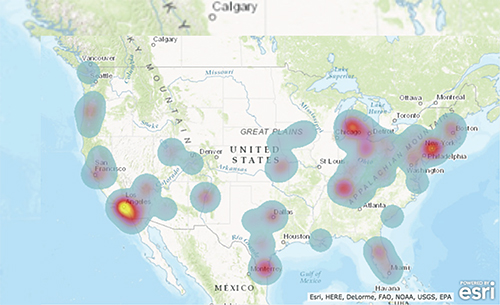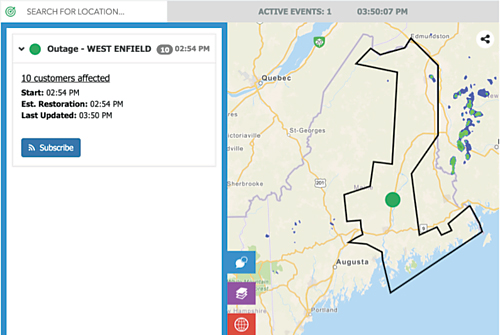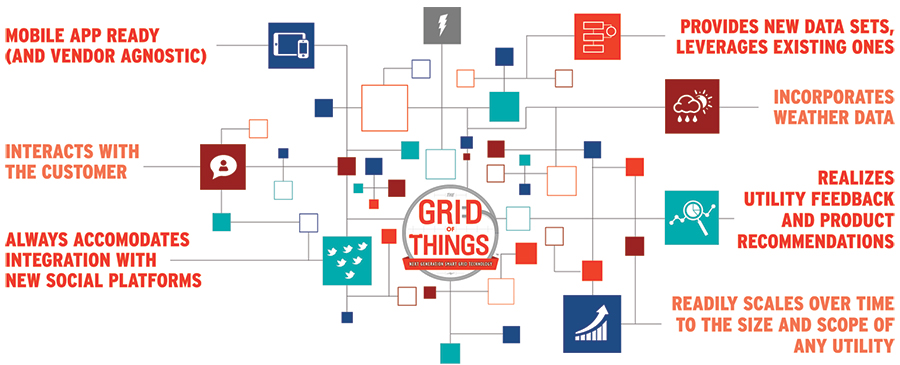Unbeknownst to me, in the Sept./Oct. 2016 issue of Electric Energy T&D Magazine, Ryan Zaczynski, DataCapable’s Data Science & Analytics Director, gave away a big secret. My vision of the Future Grid:

“I want my toaster to talk to my Utility.”
–Zac Canders
We’ve all heard about the benefits of interoperability and Ryan’s piece was a great start. In his tell-all editorial, Ryan set the stage for the Grid of Things; a simple framework by which interoperability of sensors, data, systems, telecommunications, protocol, utility teams, vendors, and the customer becomes a reality. The ink was barely dry on the press, and the editors of Electric Energy T&D asked for more insight. If Toaster-to-Utility communications were moving from the realm of ‘possible’ to ‘inevitable’ then the logical question is “how”.
So as 2017 kicks-off, it’s appropriate to provide some inspiration and recommendations for anyone out there that wants to be part of the interoperability story. A step-by-step guide on how to embrace interoperability.
BECOME INTEROPERABLE
Grid Interoperability is the proverbial jam of my demand-response made toast! Across these past few years’ vendors and utilities across the World have joined together to improve service reliability and embrace the dynamic needs of electricity customers. Interoperability is a challenge that is uniting power system engineers, utility professionals, software developers, and energy executive teams. Together we are solving complex utility problems and driving change.
And as my travels have taken me to nearly every corner of the planet, I’ve had the opportunity to witness a common, and much-needed, theme emerge. Interoperability is Easy.
Have you ever found yourself asking…
Why can’t utilities share their data in real-time with other utilities?
Why can’t product and service providers and emerging startups seamlessly access utility data?
Why isn’t it easier to collaborate with utilities and other product and service providers?
HOW TO BECOME AN INTEROPERABILITY LEADER
Back in the days of 2014, no utility on the planet could share their outage data via a standard. Please go make a cup of coffee, sit down, and reflect on this for a minute. In a world connected by a whole lot of wires the one thing we, the utility industry, couldn’t do was share outage data during disasters or large-scale grid events.
How did we build a grid that couldn’t share data? I pointed a finger of blame at utilities, regulators, and even the vendors supporting the industry. Soon I realized, it wasn’t the fault of these parties. If the Grid was going to change, then the people supporting it would need to collaborate. It was time to take the first step in the journey of interoperability.
Step 1: Build the Collaboration
Utilities across the planet have sought solutions to provide holistic views of damages and grid events to support each other with the sharing of crews and assets during times of natural disaster. The value is very clear:
- Energy managers for grocery stores across the World have dreamt of the day that outage data could help them identify when to provide mobile generation services or contact donation organizations to prevent food spoilage.
- Emergency responders on every continent (minus Antarctica) have been begging for ways to understand when and where to stage shelters and supporting crews during a crisis.
- Insurance firms have dreamt of ways to minimize and predict the impact of large weather events, thereby mobilizing adjusters faster and reducing the burden of breakdown insurance on their clients.
The first step in every interoperability journey is getting support from vendors, utilities, customers, regulators, and associated energy stakeholders. In the example of getting outage data shareable, leaders from across the World united, built a forum to discuss the plan of attack, and assigned roles and responsibilities. Together the Collaboration ensured that security, technology architecture, standards, feedback, and goals of interested parties were accounted for.
Step 2: Put an API on It
Think of an API as a contract. It details the exact structure of request and response. It provides a documented, upfront approach on how to work with data and will remain constant over time.
Once you have your interoperability use case, the next step in the journey is Step 2: Put an API on it. Specific to Step 2, interoperability isn’t bolted on, it needs to be part of the entire journey. By providing an Automatic Programming Interface (API) you are doing two things:
- You are embracing the core fundamentals of interoperability. You are agreeing to share your data via standards and best practices in software development. You believe in the power of making your data available to others:
- Product and service providers no longer compete on data but rather the information that can be derived.
- Product and service providers no longer compete on data but rather the information that can be derived.
- You are actively joining the club that wants to kill vendor lock-in:
- Gone are the days where siloed systems and solutions are embraced (or even enforced) at utilities and within product and service organizations.
In the outage data example, the Collaboration started an interoperability party. By spinning an interoperable tune, others showed up to the dance. Additional utilities, vendors, and interested parties from across the World have started getting involved in both the sharing and requesting of outage data via the API. By following the guide detailed here within, the Collaboration made interoperability easy (Step 1) and expanded the value by having an API (Step 2).
The outage data standardization leveraged the Common Information Model (CIM), a standard developed by the electric power industry that has been officially adopted by the International Electrotechnical Commission (IEC). The outage standard provides real-time, utility-sourced, outage information from across the planet.

Image 2: Outage events from across the World can be easily visualized in a
myriad of applications. All provided by the Collaboration that embraced interoperability.
Step 3: Actively Support Interoperability with Standards
Embracing Step 3: Actively Support Interoperability with Standards may be the hardest (and most time consuming) part of the journey. While I’ve spoken to how true change takes passion and an API, Step 3 and the role of standardization is a key component that can’t be overlooked.
In Step 2, I spoke of the International Electrotechnical Commission (IEC) standard for outage data shareability. By leveraging the power of the CIM standard (Common Information Model), a passionate and dedicated group of utility professionals and leading software firms did something truly remarkable. The collaboration shared outage data in real-time across each other’s systems and service territories via a standard. As of January 2017, seven utilities and ten globally recognized product and service providers have embraced the Outage Data Initiative (ODI) standard. So who lead the charge on standardization?
You guessed it!!!
The Collaboration (Step 1). This included technical experts, geo-spatial leaders, software developers, engaged utilities, passionate governmental organizations (including the United States White House Office of Science and Technology Policy). This included leading utility experts that supported and designed the API, authentication, security and IT architecture.
If the Collaboration was going to provide the World with global power outage data, it had to align with Step 3: Actively Support Interoperability with Standards. Sure, the Collaboration could have shared outage information without a standard. But by embracing a standards-based approach, the Collaboration ensured that the current and future users of this data would benefit from the well-defined common set of objects and relationship represented in the outage standard.
While Step 3: Actively Support Interoperability with Standards was the hardest part of the journey. The financial value for utilities and their customers is extremely clear. In September 2016, an electric utility in the northeast United States asked a new market entrant to include standardized outage data in their application. The integration effort took a remarkable 14-minutes to have real-time outage data visible inside the vendor’s application. All provided via a standards based approach to interoperability.

Image 3: Standardized Outage Data as overlaid with weather imagery.
THIS GRID OF THINGS STORY HAS JUST STARTED...
We’re all pushing to make the grid safer, more reliable, and ready for renewables integration. Hopefully, you are as excited as me to join this Grid Interoperability journey. I personally want each and everyone of you to get involved. Send me a note at Zac@DataCapable.com.
Collaboration, standards, and APIs will drive the next generation of utilities and it won’t happen without your involvement. Across the coming months, the Collaboration mentioned in this article will be supporting a five-part editorial series on “The Grid of Things” for Electric Energy T&D. It will conclude in an industry first (and extremely exciting) demonstration that’s going to require your help.
About the Author
 Zac Canders is the Co-Founder and CEO of DataCapable. In this role, he leads DataCapable’s worldwide delivery of the UtiliSocial platform. The first customer engagement system designed for utilities. He is passionate about the reliability of the global grid and “Connecting to the Customer of 2017”. He has also authored numerous papers and extensively supports interoperability initiatives.
Zac Canders is the Co-Founder and CEO of DataCapable. In this role, he leads DataCapable’s worldwide delivery of the UtiliSocial platform. The first customer engagement system designed for utilities. He is passionate about the reliability of the global grid and “Connecting to the Customer of 2017”. He has also authored numerous papers and extensively supports interoperability initiatives.









